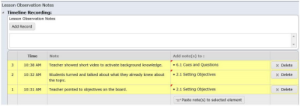When McREL first introduced the informal observation software Power Walkthrough® (PWT) in 2007, it answered an emerging need for principals and school leaders to gather informal data as they conducted walkthroughs in their classrooms. The purpose was to have an informed understanding of what instruction looked like in their schools and to help guide faculty conversations and professional development (PD) efforts.

We’ve also noticed that, once a school has been using PWT for some time, school leaders often find themselves wondering about next steps. They have the data they need, but aren’t sure, beyond scheduling PD sessions and book studies, how to address instructional gaps that their walkthrough data show as evident.

One feature of Power Walkthrough Coach, for example, is a time-stamped observation tool (see figure 
Power Walkthrough Coach also provides self-reflection tools and growth charts so that teachers can see their own progress as they learn new skills and techniques. As with PWT, Power Walkthrough Coach is not intended to be evaluative, but rather to give coaches and teachers tools to aid in improving their craft and helping learners in the most effective way possible.
All existing PWT users will be automatically converted to Power Walkthrough Coach on July 1. Look for more information in the coming weeks.
Elizabeth Ross Hubbell is a principal consultant in the Center for Educator Effectiveness, and co-author of Classroom Instruction That Works (2nd ed.), Using Technology with Classroom Instruction That Works (2nd ed.), and The 12 Touchstones of Good Teaching.
Lisa Maxfield is managing consultant in McREL’s Center for Educator Effectiveness. To learn more about Power Walkthrough Coach, contact her at lmaxfield@mcrel.org or 303.632.5561.


